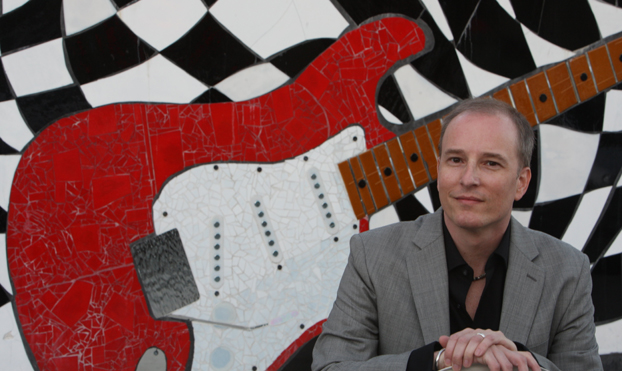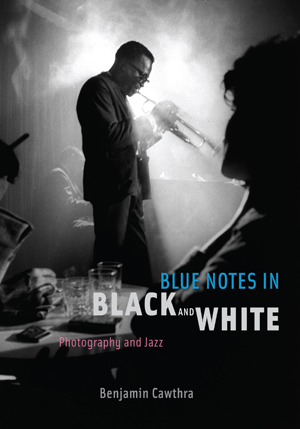 Caption: Historian Benjamin Cawthra’s first book features jazz and photography and their significance in American history. Photo by Karen Tapia/courtesy Benjamin Cawthra
Caption: Historian Benjamin Cawthra’s first book features jazz and photography and their significance in American history. Photo by Karen Tapia/courtesy Benjamin Cawthra
Candid ‘Blue Notes’
Historian’s Book Focuses on Jazz and Photography
THE YEAR LEGENDARY jazz musician Miles Davis would have turned 75, Benjamin Cawthra produced a museum exhibition in St. Louis, Mo., where Davis grew up. Photographs of Davis, his music, interviews and artifacts from Davis’ life were displayed in Cawthra’s 2001 exhibit. But, it was “the photographs that really grabbed me,” the historian said.
 Caption: The cover of Benjamin Cawthra’s book features this 1957 photograph of Miles Davis by Dennis Stock. Copyright Dennis Stock/Magnum Photos
Caption: The cover of Benjamin Cawthra’s book features this 1957 photograph of Miles Davis by Dennis Stock. Copyright Dennis Stock/Magnum Photos
The images so captivated Cawthra, associate professor of history and associate director of Cal State Fullerton’s Center for Oral and Public History, that he turned his fascination into his doctoral dissertation in 2005.
Today, “Blue Notes in Black and White: Photography and Jazz” (October 2011, University of Chicago Press) marks the culmination of Cawthra’s research on the topic.
The book, Cawthra's first, introduces jazz photographers — including Gjon Mili, William Gottlieb, Herman Leonard, Francis Wolff, Roy DeCarava and William Claxton — and their struggles, hustles, styles and creative visions of their subjects, including Davis, Duke Ellington, Dizzy Gillespie and Billie Holiday. It explains how and why the photographs were produced and argues for their significance in American history.
“My book is about African Americans achieving visibility, and about what jazz has meant and can mean,” Cawthra said, adding that he was inspired by one of his favorite novels, “Invisible Man.”
“I weave the great jazz lover and sometime photographer Ralph Ellison through the narrative of my book because I was really inspired by his concept of invisibility, expressed so well in ‘Invisible Man.’ Ellison called jazz — with its rhythmic flow, its room for improvisation, its soulfulness in the face of injustice — 'equipment for living.’ ”
While not a traditional coffee table book, “Blue Notes” features 70 compelling images in the history of jazz photography.
Q & A With the Author
Cawthra recently answered the following questions about his book and research passion:
Q: Why did you write “Blue Notes”?
I have a background in African American history and have always loved music. I'm also a closet art historian, an enthusiastic amateur. It all came together when I was working for the Missouri History Museum in St. Louis. I told myself that the one thing I needed to accomplish there was to create an exhibition on native son Miles Davis. People who had lived there all their lives had no idea he was from the area.
Also, when doing research in New York one fall, I had been invited to attend a session of Columbia University's Jazz Study Group. The subject was “Jazz and the Art of Photography,” and the idea was to generate new scholarship on the topic since it was pretty wide open. That got me thinking. So, when I went to work on my dissertation at Washington University, I had the crazy idea of investigating the history of jazz photographs.... I walked into my new adviser's office and there was a poster of a Roy DeCarava photograph of John Coltrane on the wall. I didn’t feel so crazy after that.
Q: What is it about jazz and photography that fascinates you?
I’m probably drawn to the mood, the attitude in certain types of musical expression and in the work of some photographers. Much has been said about how both jazz and photography involve improvisation, that both function in the moment. That's attractive, but it only works if the preparation is there. It is the opposite of making it up as you go along, though there are always happy accidents and discoveries in real time. There is really no faking it in either realm. But that goes for anything that is good.
As a historian, the subjects interest me in the way that novels and films and paintings do: I try to not only analyze the aesthetic power of these works, but also understand the processes of their creation, dissemination and reception, and how those processes interact with social and political change across time. I'm guilty of making an album cover more than an album cover.
Q: Do you teach about jazz or photography history in your classes?
I use them in my courses, but I try more than anything to function in a way that is informed by both of them. I'm not teaching so much as exploring with my students — looking for the right note like a musician, patiently struggling toward that decisive moment like a great photographer. We're trying to get to a place where the connections are made and we begin to grasp where the journey has been taking us. The process fascinates me more than the result. That goes against what the world of education seems to be demanding these days, but so be it.
This book led directly to my new course, “Visual History.” Students are thinking hard about how historians can make use of images as evidence, and they get to test it out themselves by writing a paper using visual sources. As one of my students famously said, he now knows less about photography than before he took the course. And, it is true. Photographs have all kinds of mysteries, contexts and histories that go well beyond whatever is portrayed in the image itself, and that context often shifts our understanding of what we are seeing, sometimes dramatically. It makes you more skeptical of everything you see.
Q: While doing the research for your book, what was the most interesting information you found?
In an interview in his home in Great Neck, N.Y., William Gottlieb told me that his classic photographs of jazz musicians from the 1940s languished in shoe boxes in his home until 1979 after having been published in Down Beat magazine of that era. Most of the jazz images that are well-known today had very small audiences or extremely limited publication histories at the time of their making. Looking through even the jazz magazines from that period, most of the photography and news coverage was of white musicians who are not well-remembered today. Not that they didn’t make good music or earn their popularity, but we know that the real innovation was happening elsewhere. Thankfully, there were a few photographers like Gottlieb and Herman Leonard who made what became almost fugitive images of people we now think of as geniuses — Dizzy Gillespie, Thelonious Monk, Billie Holiday.
Q: What do you want your readers to learn?
It is cliché now to talk about the significance of images in a situation where our multimedia world makes images of all kinds so readily available. I hope the book shows that it is worth stopping long enough to investigate images rather than simply consume them, or letting them consume you. Perhaps more important, I think the book underlines the importance of race as a factor in American history.
Segregation and discrimination are woven into the social fabric of this country, with tragic consequences. But, it is also a story of resistance. Perhaps readers would not think of Duke Ellington as a political figure, as someone taking this inequitable situation and turning it into something noble and beautiful and strong. I guess I would want readers to understand what Ellington was talking about when he insisted that African Americans were the "shot in the arm" that reminded America of its “forgotten principles.” And how the image of African Americans changed through time from the 1930s to the 1960s and why that change occurred.
The writer in me doesn't want to teach at all, though. I want readers to be lured into a world of words and images and to have an experience they can’t get anywhere else. I hope they find their own way through that experience, learn about themselves, as much as about my subject, and come away, at the end, changed in some positive way.
Q: Who is your favorite musician?
I like all kinds of music, but Miles Davis has to be at the top. Basically, there is a dividing line in my life: before I heard “Kind of Blue” and after. I like the story, the many phases he went through musically while maintaining his own personality. He forced people to ask, “Is this jazz?” multiple times. He had artistic fearlessness, a creative confidence that I really admire. And, I love that he knew how to pick future leaders as sidemen and then said virtually nothing to them about what to play. He had already heard where they would go together. Speech was superfluous.
In New York once, I was at Sony and got to hold the master tapes of “Kind of Blue” in my hands. They said the last visitor who had held them had broken down and cried. I admit that I felt a little shaky.
Q: Who is your favorite photographer?
I love W. Eugene Smith, that tortured soul. His images of New York’s Flower District from outside his loft window move me as much or more than the pictures he made of the “jazz loft” one floor up in his building. Roy DeCarava is soulful, too. Dorothea Lange on the road, Walker Evans in the South, Alfred Stieglitz in New York, Atget in Paris — all of these photographers take you not to a place you know or can visit; instead, they created new worlds within their photography, elusive myths that continue to trouble and entrance.
Q: What’s next?
I’m beginning what I expect will be a long-term project on U.S.-Italian cultural exchange in the early postwar era. It is a chance to investigate the influence of jazz in Italy, of Italian film in America, and the various meanings such cultural trends had as the two countries positioned themselves after the end of fascism and war. I’m starting with the basics: learning Italian and investigating an Italian jazz magazine that began publication just months after the war in Europe ended. I will be visiting Italy’s largest jazz archive in Siena next summer when I am done teaching in our Study Abroad Program in Florence. I’m also slowly inching forward on a project that deals with the uses of history during the Civil War era, starting with Washington Irving’s biography of George Washington.
Oct. 28, 2011
